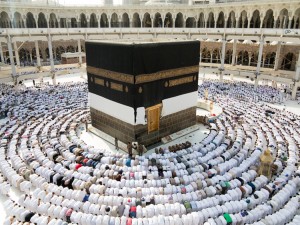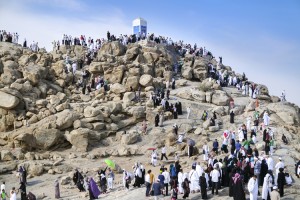Performing the Hajj
September 14, 2016
Since last weekend, nearly 2 million Muslims have descended on Mecca, Saudi Arabia, for the 2016 hajj, an annual holy pilgrimage (it ends tomorrow). The hajj (Arabic for pilgrimage) is one of the Five Pillars of Islam, formal acts of worship that provide the framework for a Muslim’s life. The Qur’ān, the holy book of Islam, commands all Muslims to make a hajj at least once in their lifetime if they are physically and financially able to do so. According to Saudi Arabia’s General Authority for Statistics, the 2016 hajj truly was a global event. Of the 1.86 million pilgrims who attended, more than 70 percent came from beyond Saudi Arabia. The 2016 hajj also was notable for increased security and crowd-control measures after a stampede in 2015 killed more than 700 people. Such measures included the deployment of security personnel, the installation of hundreds of new surveillance cameras, and the distribution of electronic identification bracelets containing pilgrims’ personal data.

Muslims pray at the Kaaba in Mecca’s Great Mosque during the annual Hajj pilgrimage in Saudi Arabia. Credit: © Shutterstock
The hajj takes place each year during Dhūl-Hijja, the 12th month of the Islamic calendar. It includes several rites that commemorate the trials and sacrifices of the prophet Abraham, his wife Hagar, and their son the prophet Ishmael. During the hajj, pilgrims wear special garments and circle the Kaaba, the most sacred shrine of Islam, seven times. Muslims believe that Abraham and Ishmael built the Kaaba as the first house of worship to God. It is an empty, cube-shaped building in the center of the Great Mosque in Mecca. Muslims all over the world face the direction of the Kaaba every day when they pray. During the hajj, pilgrims also visit Mount Arafat, a site outside of Mecca where the prophet Muhammad delivered his final sermon. Another rite involves the gathering and casting of stones at special pillars to symbolize a rejection of Satan, or the Devil.

Muslims visit Mount Arafat, the site of Muhammad’s final sermon, during the Hajj in Saudi Arabia. Credit: © Hikrcn/Shutterstock
The major Muslim festival of `Īd al-Ad-hā (also spelled Eid al-Adha) coincides with the later part of the hajj. The name of the festival means Feast of the Sacrifice in Arabic. During `Īd al-Ad-hā, Muslims gather an hour after sunrise in open spaces or in mosques to perform a community prayer. Muslims who can afford it sacrifice an animal, such as a camel, cow, goat, or sheep. The sacrifice honors Abraham’s willingness to sacrifice his older son, Ishmael, and God’s decision to substitute a ram instead. The Qur’ān explains that the sacrifice is not an offering of meat to God, but a holy act of sharing food. Those who sacrifice share with the poor and with their neighbors. During the festival, children receive gifts, and people visit family and friends.
Some Muslims complete the hajj multiple times during their lives. Muslims believe a person who makes such a pilgrimage secures great religious merit. In addition to having religious significance, the hajj has great economic importance for the city of Mecca. The city has some minor industries, but its economy depends on money spent by the great number of pilgrims who visit each year.


